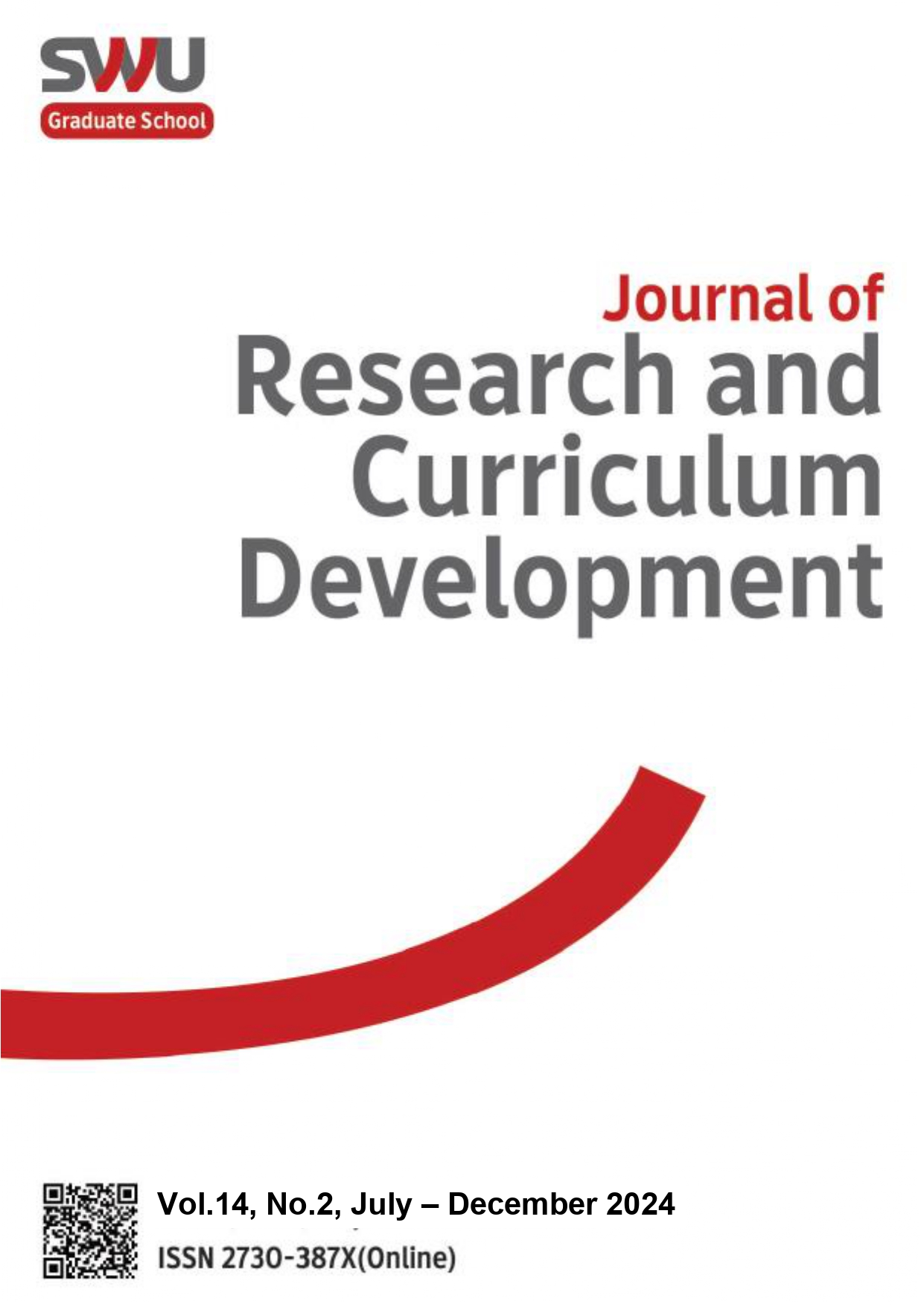Development of Web-based Application for Nakhon Pathom Community-based Tourism in French for High School Students
Keywords:
Web-based application, French for community-based tourism, Listening and speaking in French, SatisfactionAbstract
The purposes of this research were to develop a web-based application in French for Nakhon Pathom community-based tourism for high school students and to examine the effectiveness of the web-based application in terms of French listening-speaking ability for community-based tourism and satisfaction from the application. The research instruments were: 1) an interview form about community-based tourism in Nakhon Pathom Province; 2) a web-based application in French for community-based tourism in Nakhon Pathom Province for high school students; 3) a French listening-speaking ability test for community-based tourism; 4) a French oral test for community-based tourism; and 5) a satisfaction questionnaire with the developed web-application. The statistics used in the research included mean, standard deviation, and dependent t-test. The results showed that 1. the web-based application in French for community-based tourism in Nakhon Pathom Province for high school students consists of 1) principles, 2) objectives, 3) learning activities of 9 lessons, and 4) measurement and evaluation. 2. Regarding the trial, 2.1 students’ listening-speaking ability in French for community-based tourism after learning was higher than before learning with statistical significance at .05 level. Their listening-speaking ability in French after learning was higher than the set criterion of 70% with statistical significance at .05 level. 2.2 Overall, the students’ satisfaction with the developed web application was at a high level. For further development, researchers can apply this approach in developing the application to other courses or curriculum. The findings of this research are the application should be function in various systems, iOS or android; the lessons must be presented to attract interests, be practical, and be interactive to support a fast learning; be frequently responsive for lesson output; and be encouraged little by little for a continuous development of the skill.
References
Andrejević, D., & Nejković, V. (2022). E-learning web application for teaching English for specific purposes - English at a Click. The Journal of teaching English for Specific and Academic Purposes, 10(1), 13-29.
Brown H. D. & Lee, H. (2015). Teaching by principles: an interactive approach to language pedagogy (4th Ed.). Pearson Education.
Brunelière, J. F. et Oliveira, C. L. P. (2016). La pédagogie de projet en cours de FLE: Expérience dans un collège brésilien. Revista Letras Raras, 5(3), 100-114.
Department of Tourism (Thailand). (2021). International Tourist arrivals to Thailand. Retrieved October, 2022 from ww.mots.go.th/more_news_new.php?cid=411
Diez, M. T. (2020). Developing speaking skills and learning pronunciation with new technologies in the French as a foreign language classroom. Archivum, 12(2), 325-358.
Istiqomariyah, I., Sutomo, M., & Fatmawati, E. (2023). Application of Behavioristic Learning Theory in Thematic Learning. EDUTEC: Journal of Education and Technology, 6(3), 932-941.
Ministry of Education. (2008). Basic education core curriculum B.E. 2551 (A.D. 2008). Office of the Basic Education Commission of Thailand.
Nggawu, L. O. & Thao, N. T. P. (2023). The impact of communicative language teaching (CLT) approach on students’ speaking ability in a public Indonesian university: comparison between introverts and extrovert groups. International Journal of Language Education, 7(3), 393-413.
Palilonis, J., Butler, D. & Pamela, L.F. (2013). Design Interactive: A nonlinear, multimedia approach to teaching introduction to visual communication and principles of design. Journal of Educational Multimedia and Hypermedia, 22(1), 128-135.
Panggua, S., Aeni, N., Rachel, Patanduk, S.T., Arrang, J.R.T., Tulaktondok, L. & Sirande, N. (2023). The Perceived Impact of Comprehensible Input on EFL Students’ Listening and Speaking Skills. In M. Kristiawan et al. (Eds.), Proceedings of the Online Conference of Education Research International (OCERI 2023) (pp.613-623). Bengkulu: Atlantis Press.
Raine, P. (2018). Developing web-based English learning applications: Principles and practice. CALL-EJ, 19(2), 125-138.
Rama, A. N., Ahmad, D. R. P., & Nurwanti. (2022) The effect of English listening and speaking application on students’ listening skill at Lakidende University. Journal Pendidikan dan Konseling, 4(3), 1166-1171.
Richards, J. C. & Rodgers, T.S. (2014). Approaches and methods in language teaching. Cambridge University Press.
Sayamon Insa-ard. (2018). A Design of e-Learning Lessons to Enhance Advance Thinking Skill. SE-Education.
Schunk, D. H. (2021). Learning Theories: an educational perspective (8th Ed.). Pearson.
Siriphanich, P. & Tasanameelarp, A. (2017). Using web-application in training to enhance oral English proficiency of the local tour guides in southern Thailand. Journal of Tourism & Hospitality, 6(6), 1-5.
Togaibayeva, A., Ramazanova, D., Yessengulova, M., Yergazina, A., Nurlin, A., & Shokanov, R. (2022). Effect of mobile learning on students' satisfaction, perceived usefulness, and academic performance when learning a foreign language. Frontiers in Education, 7, 1-9.
Zhong, Y. (2023). Project-based language learning and its implications for English teaching in Chinese universities. Lecture Notes in Education Psychology and Public Media, 31, 102-109.
Downloads
Published
How to Cite
Issue
Section
License

This work is licensed under a Creative Commons Attribution-NonCommercial-NoDerivatives 4.0 International License.





